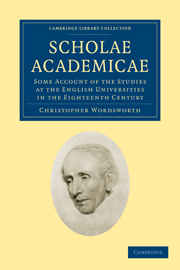 Scholae Academicae
Scholae Academicae Published online by Cambridge University Press: 07 September 2010
‘There is figures in all things.’
K. Henry V. Act vi. Sc. 7.A university speech made probably in the year 1654 by Isaac Barrow (who a few years later had the singular fortune to be predecessor of Newton as Lucasian professor, of Bentley as. master of Trinity, and of Porson as Greek professor) will give the reader a notion of the progress of Cambridge mathematics previous to the appearance of Newton.
‘Nempe Euclidis, Archimedis, Ptolemaei, Diophanti, horrida olim nomina iam multi e uobis non tremulis auribus excipiunt. Quid memorem iam uos didicisse arithmeticae ope, facili et instantanea opera uel arenarum enormes numeros accurate computare’ &c.—After referring to astronomical studies, he continues—‘Sane de horribili monstro, quod Algebram nuncupant, domito et profligate multi e uobis fortes uiri triumpharunt: permulti ausi sunt Opticem directo obtutu inspicere; alii subtiliorem Dioptrices et utilissimam doctrinam irrefracto ingenii radio penetrare. Nee uobis hodie adeo mirabile est, Catoptrices principia et leges Mechanicae non ignorantibus, quo artificio magnus Archimedes romanas naues comburere potuit, nee a tot saeculis immobilem Vestam quomodo stantem terrain concutere potuisset.’
And, to speak the truth, this was a matter of congratulation for seventeenth-century Cambridge. For while we are not content that it should now be considered as exclusively ‘the mathematical university,’ or that the tripos in the last century should be called ‘the mathematical tripos,’ it appears that about 1635 it was not mathematical at all.
To save this book to your Kindle, first ensure [email protected] is added to your Approved Personal Document E-mail List under your Personal Document Settings on the Manage Your Content and Devices page of your Amazon account. Then enter the ‘name’ part of your Kindle email address below. Find out more about saving to your Kindle.
Note you can select to save to either the @free.kindle.com or @kindle.com variations. ‘@free.kindle.com’ emails are free but can only be saved to your device when it is connected to wi-fi. ‘@kindle.com’ emails can be delivered even when you are not connected to wi-fi, but note that service fees apply.
Find out more about the Kindle Personal Document Service.
To save content items to your account, please confirm that you agree to abide by our usage policies. If this is the first time you use this feature, you will be asked to authorise Cambridge Core to connect with your account. Find out more about saving content to Dropbox.
To save content items to your account, please confirm that you agree to abide by our usage policies. If this is the first time you use this feature, you will be asked to authorise Cambridge Core to connect with your account. Find out more about saving content to Google Drive.